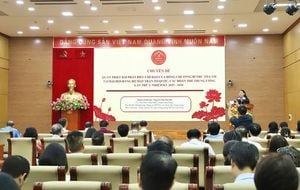During the recent vice presidential debate, Sen. JD Vance made headlines by attributing America’s rising housing costs to immigration, particularly illegal immigration. He stated, "You have got housing that's totally unaffordable because we brought in millions of illegal immigrants to compete with Americans for scarce homes." Vance’s comments amplified the narrative pushed by former President Donald Trump, who has been vocal about limiting immigration to tackle various domestic issues.
But how accurate are these claims? Various experts and economists are stepping up to challenge the link between immigration rates and skyrocketing housing prices, pointing to several structural factors at play.
Vance referenced what he described as significant studies by the Federal Reserve which allegedly demonstrate the tie between increased migration levels and rising housing prices. Yet, what he highlighted was not actually rigorous research but rather short remarks made by a Fed official indicating some upward pressure on rents due to immigration inflows. Many economists argue his interpretation oversimplifies and misrepresents the complex dynamics of the housing market.
Experts like economist Paul Krugman have critiqued Vance’s assertions, noting, "The surge in rents preceded the surge in immigration." According to data, home prices across the United States have surged approximately 53% since January 2020, with rents rising about 25% over the same period. This dramatic increase has left many renters and potential homebuyers feeling financially squeezed.
While it’s true some studies insinuate even slight increases in rental costs correlate with population boosts due to immigration—one study noted a 1% rise could yield about 0.8% higher rents—the overarching view among those focused on the housing market is much different. Economists have elucidated various significant elements driving these housing issues, emphasizing the dire problem of insufficient housing supply as the crux of the affordability crisis. Skylar Olsen, chief economist at Zillow, stated succinctly, "The housing shortage is the root cause of our affordability crisis."
Indeed, Angela Williams, the executive director of the National Housing Law Project, accentuated the point: "Simply put, there aren’t enough homes where they are needed, and this drives up prices, making it difficult for households to keep up with housing costs." She calls for more construction and reformative laws to alleviate the supply issue.
The housing crisis can also be partially attributed to demographic trends. Millennials have recently entered the ideal age span for homebuying, yet supply remains constrained as many baby boomers are remaining in their homes. This has inadvertently led to increased competition within the market, adding to the upward pressure on prices.
Interest rates play another substantial role. Since the COVID-19 pandemic began, low mortgage rates have enabled many eager buyers to jump on property, fueling demand even more. This has created intense competition for homes, worsening the issue. During the debates, Vance and his counterpart Tim Walz also discussed some of these factors, yet the focus often remained on immigration, obscuring the economic reality most analysts recognize.
Importantly, the notion put forth by Vance and Trump about deporting millions of immigrants as part of the solution raises significant concerns. Many workers involved within the construction sector, which has already been facing labor shortages, are immigrants. If deportations were enacted, it could negatively impact the construction industry, exacerbates the lack of available housing. Roller of the National Housing Law Project emphasized, "About one-third of workers in construction are immigrants. Deporting them could complicate the existing housing situation."
Meanwhile, immediate solutions proposed—such as developing new homes on federal lands—are met with skepticism. While building new homes is necessary, various questions arise on the implementation, particularly on logistical aspects and actual land suitability.
Back to Vance’s claims about immigrants, experts have pointed out legal statuses of many immigrants, including those from Haiti who reside within Springfield, Ohio. Vance’s statements mislabel these individuals, declaring them “illegal” without acknowledging the Temporary Protected Status many possess which legitimizes their residence. Such programs, as explained by immigration advocates, provide Haitians legal status, enabling work and protections from deportation.
Opponents of Vance's argument urge viewing the immigration issue as part of the wider structural problems affecting housing. Studies suggest significant reasons, such as prolonged economic factors stemming from the Great Recession, which limited new constructions and contributed to the current shortage of available homes and rising prices.
All perspectives considered, the relationship between immigration and housing costs is complex and multifaceted. Experts and economic analyses suggest the root causes lie not within the migrant population but instead within deep-seated economic structures and current housing market trends. This calls for broader policies than merely depicting immigration as the scapegoat for societal concerns surrounding housing affordability. To truly tackle this issue, dialogue should pivot toward constructing more homes and exploring policies geared toward actual relief for struggling Americans.
This recent debate has sparked additional queries within the public and prompted experts to engage more actively with these claims. They establish the importance of clarifying misinformation and underscoring the factual basis of policies surrounding immigration and housing, and the electorate's response will likely shape discussions heading forward.
While Vance interprets the connection between immigration and housing costs negatively, numerous policy experts, economists, and housing advocates encourage focusing discourse on strategies to effectively increase housing supply and address affordability directly, without vilifying marginalized communities.



